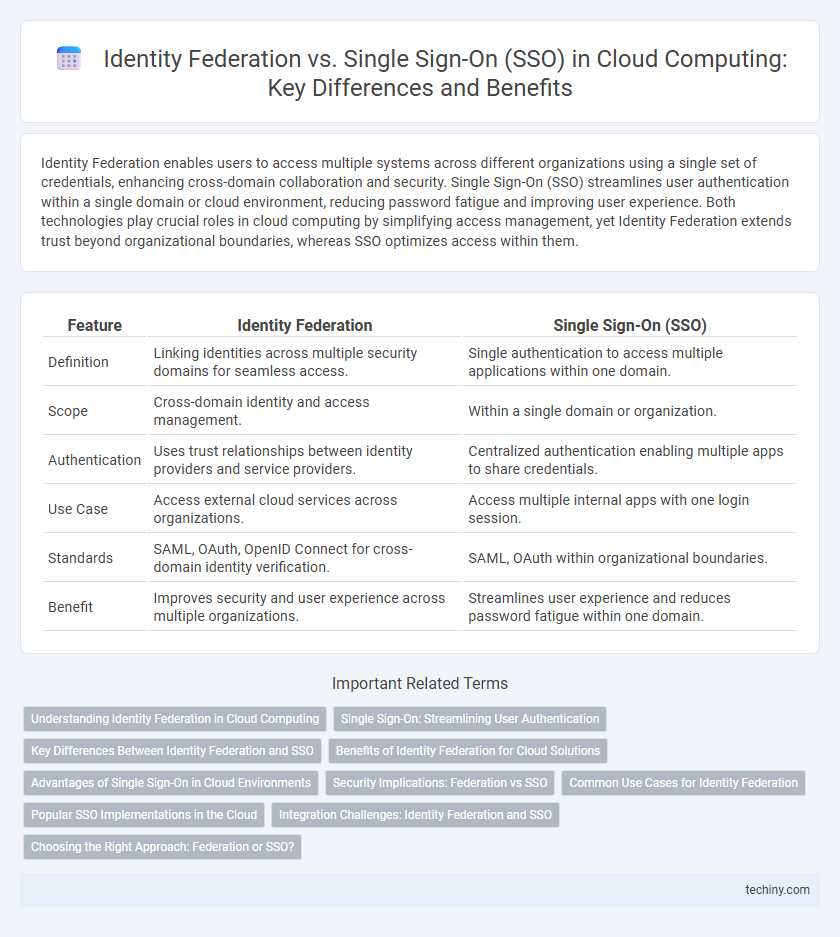Identity Federation enables users to access multiple systems across different organizations using a single set of credentials, enhancing cross-domain collaboration and security. Single Sign-On (SSO) streamlines user authentication within a single domain or cloud environment, reducing password fatigue and improving user experience. Both technologies play crucial roles in cloud computing by simplifying access management, yet Identity Federation extends trust beyond organizational boundaries, whereas SSO optimizes access within them.
Table of Comparison
| Feature | Identity Federation | Single Sign-On (SSO) |
|---|---|---|
| Definition | Linking identities across multiple security domains for seamless access. | Single authentication to access multiple applications within one domain. |
| Scope | Cross-domain identity and access management. | Within a single domain or organization. |
| Authentication | Uses trust relationships between identity providers and service providers. | Centralized authentication enabling multiple apps to share credentials. |
| Use Case | Access external cloud services across organizations. | Access multiple internal apps with one login session. |
| Standards | SAML, OAuth, OpenID Connect for cross-domain identity verification. | SAML, OAuth within organizational boundaries. |
| Benefit | Improves security and user experience across multiple organizations. | Streamlines user experience and reduces password fatigue within one domain. |
Understanding Identity Federation in Cloud Computing
Identity Federation in cloud computing enables users to access multiple cloud services using a single digital identity managed across different organizations or domains. This approach relies on standardized protocols like SAML, OAuth, and OpenID Connect to securely exchange authentication and authorization data between identity providers and service providers. Unlike Single Sign-On (SSO), which centralizes login within one organization, identity federation facilitates seamless and secure user access across diverse cloud platforms and enterprise boundaries.
Single Sign-On: Streamlining User Authentication
Single Sign-On (SSO) streamlines user authentication by enabling access to multiple cloud services with a single set of credentials, reducing password fatigue and enhancing security. By integrating with identity providers using protocols like SAML or OAuth, SSO simplifies user management and improves compliance in cloud environments. This seamless access drives efficiency in enterprise workflows while minimizing authentication-related risks.
Key Differences Between Identity Federation and SSO
Identity Federation enables secure access across multiple organizations by linking user identities from different domains, while Single Sign-On (SSO) allows users to authenticate once and gain access to multiple applications within the same domain. Federation relies on standards like SAML or OAuth to share authentication and authorization data between trusted parties, whereas SSO typically operates within a single organization's ecosystem, managing sessions centrally. Key differences include the scope of access--cross-domain for Identity Federation versus intra-domain for SSO--and the complexity of trust relationships and protocols involved.
Benefits of Identity Federation for Cloud Solutions
Identity Federation in cloud solutions enables seamless access across multiple, disparate systems by linking users' identities from different domains, enhancing security and user experience. It reduces administrative overhead by centralizing authentication management while supporting compliance through consistent access policies. This approach boosts scalability and collaboration for organizations leveraging multi-cloud environments or partner integrations.
Advantages of Single Sign-On in Cloud Environments
Single Sign-On (SSO) enhances user experience in cloud environments by enabling seamless access to multiple applications with a single set of credentials, reducing password fatigue. It improves security by minimizing the risk of credential theft and simplifying user authentication management across diverse cloud services. SSO also streamlines administrative tasks, lowering IT overhead and accelerating user onboarding and offboarding processes in multi-cloud infrastructures.
Security Implications: Federation vs SSO
Identity Federation enhances security by enabling trust relationships between multiple identity providers, reducing the risk of credential theft through decentralized authentication, while Single Sign-On (SSO) centralizes user credentials, increasing exposure if the SSO system is compromised. Federation supports cross-domain access control with token-based authentication, minimizing attack surfaces by limiting credential sharing across services. SSO simplifies user experience but requires robust protections like multi-factor authentication to mitigate the heightened risk of unauthorized access due to a single point of failure.
Common Use Cases for Identity Federation
Identity federation enables users to access multiple applications across different domains using a single set of credentials, making it ideal for cross-organizational collaborations and partnerships. Common use cases include business-to-business (B2B) integrations, where enterprises share identity information securely, and multi-cloud environments requiring seamless authentication across diverse services. This approach enhances user experience and security by reducing password fatigue and enabling centralized identity management across distributed systems.
Popular SSO Implementations in the Cloud
Popular Single Sign-On (SSO) implementations in cloud computing include OAuth 2.0, OpenID Connect, and SAML 2.0, which enable users to access multiple cloud services with one set of credentials. Identity federation often leverages these protocols to establish trust between different identity providers and service providers, streamlining user authentication across diverse cloud environments. Major cloud platforms like AWS, Azure, and Google Cloud support these SSO standards to enhance security and user convenience in multi-cloud ecosystems.
Integration Challenges: Identity Federation and SSO
Identity Federation and Single Sign-On (SSO) both streamline user access across multiple systems but face distinct integration challenges due to differing architectures and protocols. Identity Federation requires complex trust relationships and standardized protocols like SAML or OAuth to enable seamless identity sharing across heterogeneous domains, often leading to interoperability issues and security concerns. In contrast, SSO focuses on user convenience within a unified environment, where integrating diverse applications demands consistent session management and authentication token handling to prevent security gaps and ensure smooth user experiences.
Choosing the Right Approach: Federation or SSO?
Choosing between Identity Federation and Single Sign-On (SSO) depends on organizational needs for cross-domain access and user experience. Identity Federation enables seamless access across multiple security domains by linking identities from various organizations, ideal for multi-cloud or partner integration scenarios. In contrast, SSO streamlines user authentication within a single domain or organization, enhancing convenience but lacking broader interoperability features found in federation.
Identity Federation vs Single Sign-On Infographic

 techiny.com
techiny.com